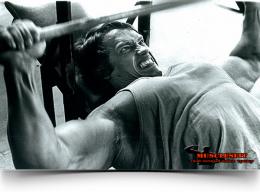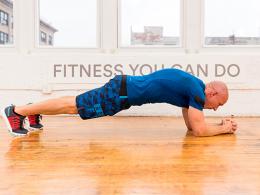How to learn to do pull-ups: secrets and practical tips
My respects, dear friends. How to learn to do pull-ups is probably the most painful question that faces any beginner who comes to the gym. I’ll say right away that this event is not an easy one, and not everyone can master it right away. Not everyone, because there are certain subtleties and tricks that are not visible at first glance, but on which most of the success in overcoming the crossbar depends.
That’s what we’ll talk about today, or more precisely: we’ll learn about why many never manage to pull themselves up, what effective tricks there are that can help in such an important activity, and a lot of other useful things.
So, first things first, key to start, let's go.
How to learn to pull yourself up: what, why and why
The dislike of pull-ups among the majority of the male population dates back to childhood, or rather, from school physical education lessons. (physicians, in common parlance). And really, remember for yourself what your favorite “events” were in physical education? I think I won’t be wrong if I say that these are all kinds of ball games, jumping over a goat, etc. The most “dishonorable” (or more simply put, shirking) there were running, push-ups and, of course, pull-ups.
As soon as the teacher says that the standards will be passed in the next lesson, half the class of boys suddenly gets sick, others forget their sneakers with their uniform, and still others reluctantly trudge along and take the rap for everyone else. It was rare to find classes in which the boys passed all the standards “cleanly”, usually the physics teacher helped - so to speak, he pulled up the times (rounded the results to a whole number with 7 before 10 and so on.). The relationship between most guys and the horizontal bar can be described as dangling, swaying from side to side and hanging in the style of a weak-willed sausage :).
Usually, the stumbling block in passing the standards was these same ill-fated pull-ups. Unlucky because no one told us how to learn to do pull-ups and how to do it correctly. Well, the time has come for justice to prevail, and everyone finally understands what’s what and why. And this is exactly what our article today is about.
So, the horizontal bar is the simplest apparatus of two vertical pillars and one horizontal cover - the crossbar, which is familiar firsthand to track and field athletes and gymnasts, as well as the “service” part of the male population. The simplicity of the design in no way detracts from its advantages; on the contrary, pull-ups are one of the most universal exercises that work out a large number of muscles.
Note:
Pull ups – translated from English as “pull up”. The cheapest and most effective way to train your arms, back and torso combined.
What prevents you from learning how to do pull-ups
Before moving on to the various “bells and whistles”, let’s look at what really prevents (prevents) you from pulling yourself up?
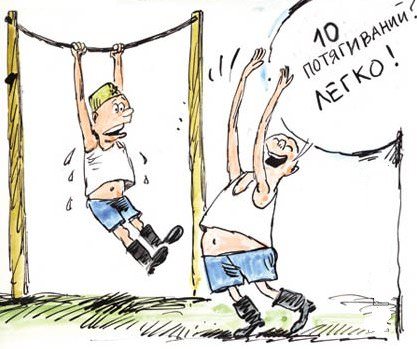
The main factors of “not tightening” are most often the same for everyone, and these are:
- overweight.
The greater a person's weight, the more total muscle effort he needs to exert to lift him off the floor. If your weight problems are quite significant (more than normal by 15-20 kg), then you can forget about pull-ups until you lose those extra pounds;
- poorly developed cardiovascular system.
It would seem, what is this for? It's very simple: the heart pumps blood. When you pull yourself up, the body’s energy increases, blood begins to fill the bloodstream more actively, and often it does not have time to push through the narrow gaps of the veins/capillaries, and the person feels darkening in the eyes and dizziness;
- general physical weakness.
If a person forgot about sports after school and, in principle, lifted nothing heavier than a “spoon”, then due to a lack of physical strength and endurance it will be difficult for him to get the upper hand over the crossbar.
- weakness of accessory muscle groups.
Pull-ups are like a long chain consisting of a set of links (various large and small muscle groups). Often the ability to improve is determined by the strength of weak links (small accessory muscles), which are lagging behind.
- incorrect technique for performing the exercise.
As a rule, those who start doing pull-ups know nothing, not only about the correct technique, but generally about the technique of performing this exercise. For the most part, the entire technique comes down to frictional movements of the pelvis, strong rocking and assisting oneself with the whole body.
- a banal lack of skill and inconsistency of muscle work.
Due to the fact that a person very rarely uses a horizontal bar, he simply lacks practical skills in this matter. There is an inconsistency in the functioning of the nervous and muscular systems. Those. the signal from the central nervous system is sent to the muscles on time, but the latter are included in the work “at odd times”.
Note:
I had a school friend, his name was Mishka. But for some reason, in physical education lessons, our physical education teacher called him “Sack.” At first I didn't understand why, then (as time passes) It dawned on me that he called it that because of its amazing ability to stick and hang helplessly on the horizontal bar, well, just like a sack, really.
So, in fact, these are all limiting factors that prevent a person from pulling himself up normally. Now let's move on to the physiology of the exercise.
How to learn to do pull-ups: physiology
If you learn how to do a good pull-up, this will automatically mean strengthening the following muscle groups on your body: muscles of the upper body (shoulders, back, chest): your latissimus dorsi muscles (wings), arm flexors and brachialis muscles will develop very strongly.
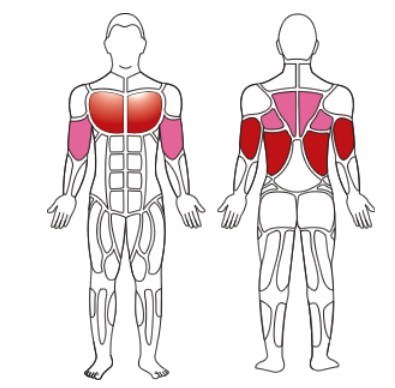
If we consider the full range of muscles involved in pulling up, then the following image from “Anatomy of Strength Exercises” will help you (clickable).
How to learn to do pull-ups: the influence of grip
Before you begin to study the various auxiliary techniques of the “pull up”, it is necessary to keep in mind that there are different grip techniques (i.e. the position of the hands relative to the crossbar). The most common grip is straight ( 2 ), there is also a reverse (1 , hand from below) and combined (3 , one hand on top, the other on bottom).
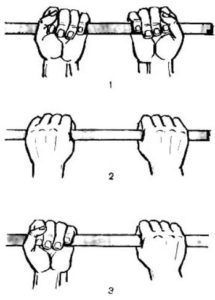
A direct grip is aimed at developing the muscles of the shoulders and back, while a reverse grip involves more flexors/extensors of the arms (biceps) in the work.
Note:
It is best to learn to do pull-ups with an overhand grip, because... It is he who involves more muscle groups in the work. For variety, it is sometimes useful to change the grip to a reverse or combined one, but you should not overuse it.
Types of grip are directly related to the width of the grip, and its degree (correlation between hands) The “angle of attack” of the load on various muscles depends. Thus, the wider the grip, the more load is placed on the back muscles. With a very wide grip, the muscles will not be fully worked due to the fact that they perform their movement at a reduced amplitude. If you use a reverse wide grip, you must fully control the movement and perform it slowly, otherwise you can damage the ligaments.
Well, now let's move on to the technical and practical tricks.
How to learn to do pull-ups: action plan
It's time to consider the specific steps that will help you master the horizontal bar. I will try to present the most detailed list of what will really help you achieve your goal - to learn how to do pull-ups. Go.
Method number 1. Preliminary strengthening of the muscle frame
As already mentioned, pull-ups are multi-joint (on par with the classic bodybuilding troika), and it uses both primary and secondary muscle groups. Therefore, before moving on to the horizontal bar, first strengthen and pump up your biceps, latissimus dorsi and rear deltoids. Also, start your bar battle with a simple hang. Try to hang for as long as possible. This way you will strengthen your grip and allow your ligaments and muscles to get used to the weight of your body. Also practice “pulling” exercises with dumbbells, kettlebells and barbells in a bent-over position (see image). They will strengthen your back well, and this is the main working muscle in pull-ups.
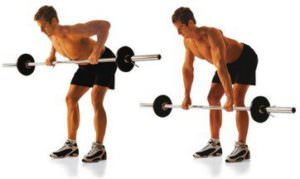
Note:
Make sure you're well before you start doing strength exercises. It's best to do a dynamic warm-up with a little cardio at the beginning.
Remember! It’s always easier to start not from “0”, but from some established base.
Method number 2. The alternative is good too
Also, the preparatory stage before “real” pull-ups can include exercises such as wide-grip lat pull-downs in a machine or gravitron (helps the athlete pull himself up thanks to the counterweight system). Also, if there are no such exercise machines in the gym, “charter” your boyfriend/girlfriend for a while, who will support you by the waist, and you will do full-range pull-ups under their constant supervision. Of course, these exercises are only an “imitation” of full pull-ups, but you will gain certain skills in mastering the movement and strengthening target muscle groups.
Method No. 3. Start small - partial pull-ups
If you cannot “cleanly” (without jerking) pull yourself up to the full amplitude, then try to pull yourself up as high as possible. Hold this top position for a few seconds and repeat again. It is necessary to take “new heights” with each new workout and stay at the extreme point.
Method number 4. Negative pull-up
Another way is to work only in the negative phase – i.e. You just lower yourself to the position of fully extended arms. The idea is this - you take any stand, place it under the horizontal bar, stand on it, take the top position and then remove your legs and slowly lower yourself down. In the upper position (when the angle at the elbow is 90 degrees) make a static delay (see image). All this will increase your strength and strengthen your tendons.
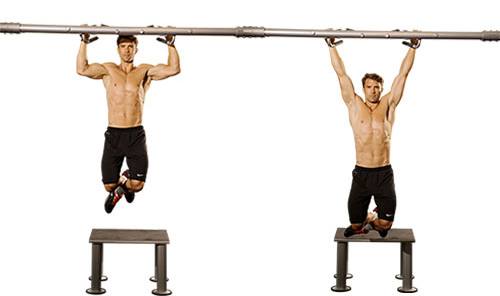
Method No. 5. “Australian pull-ups” or horizontal pull-ups on a low bar
The best option, especially for girls. The body is at an angle (30-50 degrees) to the horizontal plane, the crossbar is at chest level. Straighten your arms and then pull your chest towards the bar (see image). If problems arise with such a design, then use it, it is available in almost any gym and with its help you can easily complete this exercise, the main thing is to choose the right height of the racks.
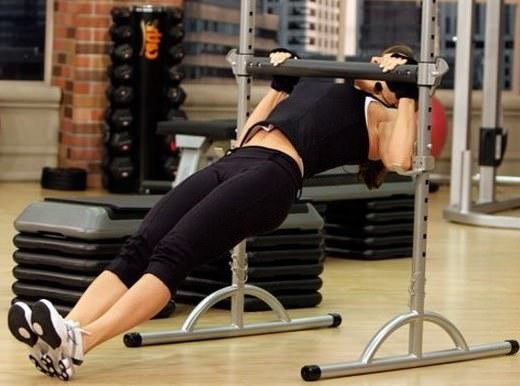
Note:
A variation of this exercise can be vertical pull-ups on a low horizontal bar. Those. You do not reach your hands up to the horizontal bar, but look for it to be lower than you (chin over bar).
Method number 6. Pull-ups
An exercise from the category of courtyards, i.e. To complete it, you need sports bars, which can almost always be found on any school grounds. Starting position - you need to grab the bars with your palms facing inward, throw your legs over the bars, arms and back straight. The technique of execution is to pull yourself up with your arms and touch your chest to the level of the bars, fix this state for a few seconds, and return to the ready position.

Method No. 7. “Rubber” pull-ups
Sports equipment is playing an increasingly supportive role in the life of an athlete. In particular, rubber bands help in mastering pull-ups. The “rubber assistant” is attached to the crossbar; a loop is formed in the lower part into which the legs/knees are inserted. When doing pull-ups, the elastic band will help you pull up.
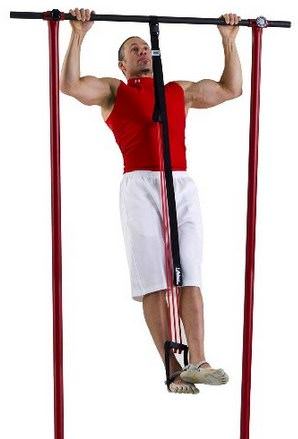
Actually, we’re done with the “how to learn to do pull-ups” tricks, now let’s philosophize a little on the topic: why many never learn to do pull-ups. Everything is very simple, often many people who cannot do a single pull-up are scared off by the very word - horizontal bar. This is related (Firstly) with psychology - “what a loser you are” :), i.e. people imagine what they will think of them when they see their “horizontal incompetence.” Thus, it turns out that all the problems are in the head. The only way out in such a situation can be to understand that this is purely your “far-fetched” point of view, but in fact, no one cares at all whether you can do pull-ups or not, everyone only thinks about their results. Therefore, feel free to jump onto the crossbar, and others will follow you.
If you are a very shy person, then organize a horizontal bar for yourself at home, for this you will need a drill, mounting angles and a metal crossbar, in particular, here is one of the design options for home use
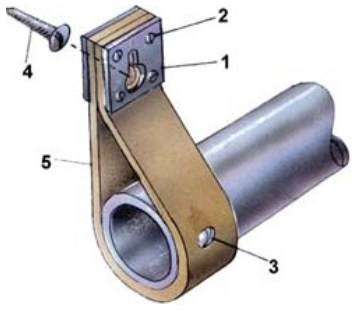
Very budget options are to adapt some kind of room door or hanging cabinet, in general, use your imagination. And you will see that a horizontal bar at home is a thing 2-5 minutes. That's all (oh really), let's move on to the conclusion.
Afterword
Today we have covered in some detail and detail the question of how to learn to do pull-ups. In the next issue, we will learn about the correct technique for working with the bar, look at how to improve your results in “pull-ups”, and also analyze effective pull-up programs. This same article has come to an end, thank you for staying with the project, see you next time.
Yes, I almost forgot, wide lats, square quadriceps and a relief washboard to boot!
PS. Don't be shy and write comments.


